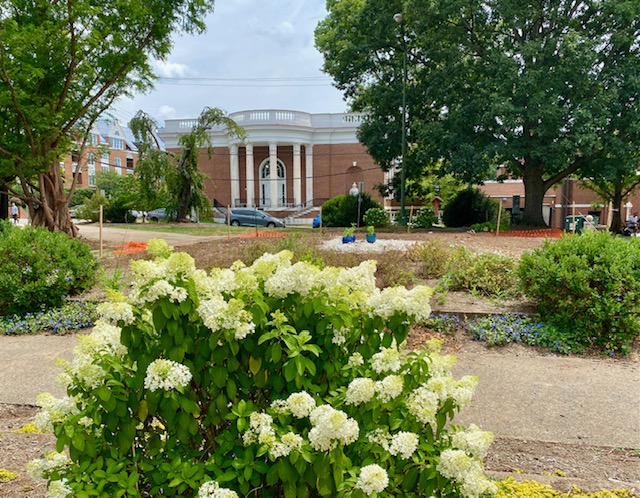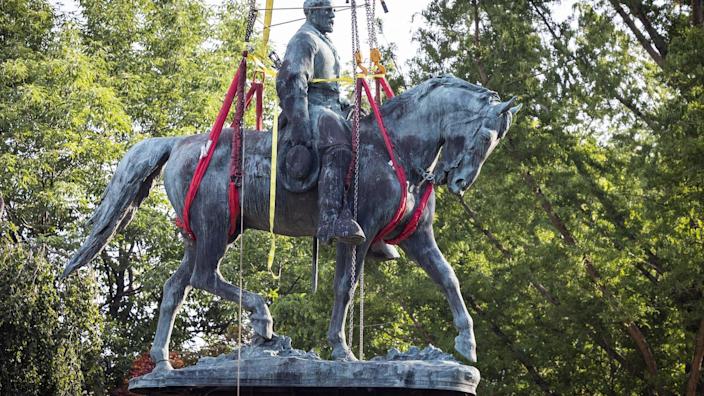By Glynn Wilson –
CHARLOTTESVILLE, Va. — This city was not a pivotal location during the Civil War from 1861-65, but the often violent and deadly battle over removing the statue of Robert E. Lee in 2017 put Thomas Jefferson’s home town front and center in the national war on Confederate monuments and how today’s generation will view America’s historical involvement in slavery.
Nearly a century after it was first erected, and almost four years after it triggered a deadly weekend of violence, the statue of Robert E. Lee sitting on horseback was hoisted into the air on Saturday, July 10, 2021, and carted away on a truck, according to Washington Post coverage at the time.
Many of those watching the bronze monument come down shared the same response: It had been a long time coming, the paper reported.
“I don’t have much to say other than this is well overdue,” said Zyahna Bryant, who started a petition while in high school in 2016 to remove the statue. “This should have happened a long time ago.”

The vacant site of the statue of Robert E. Lee on horseback is now the subject of a local debate over what will replace it: Glynn Wilson
Civil War
According to the Encyclopedia of Virginia, Charlottesville’s role in the Civil War was minor. No major battles were fought here, although local businesses did provide the Confederate war effort with swords, uniforms and artificial limbs. It was also home to a 500-bed military hospital, with up to 22,000 patients.
The 19th Virginia Infantry Regiment was organized in the summer of 1861, recruiting most of its members from Charlottesville and Albemarle County, and it served with the Army of Northern Virginia all the way through to the Appomattox Campaign in 1865, including at Pickett’s Charge in 1863 where it lost 60 percent of its soldiers.
African Americans, both enslaved and free, composed a majority of the town and county’s population between 1820 and 1890. According to the U.S. Census of 1860, the county was home to 606 free blacks and 13,916 enslaved African Americans, compared to 12,103 whites.
Charlottesville’s most prominent citizens were slaveholders, most prominently Uriah P. Levy, the owner of Jefferson’s Monticello at the time, who owned 21 slaves.
“They were invested in maintaining the antebellum social order and establishing harsh measures in instances where that order was disrupted,” the encyclopedia reports. For example: “Black people were prohibited from smoking in public, with the punishment for noncompliance being 10 lashes for slaves and a $10 fine for free blacks. Curfews were set and enforced, prohibiting any slave from leaving his or her master’s property past 9 p.m. at night without written permission.”
Authorities also cracked down on any mixing of the races. An African American man named Jackson who was living on University of Virginia property was removed in 1863 on the grounds that he was married to a white woman.
The Confederate government impressed African Americans’ labor for the war effort. Free blacks between the ages of 15 and 50 were required to report to the courthouse, where they were examined by a doctor from the Charlottesville General Hospital who determined how and where they should work. If they did not report, they were taken at gunpoint. Between 1862 and 1864, about 940 slaves were taken. In 1863, four slaves murdered a Confederate officer attempting to take them.
African Americans also took advantage of the shifting social conditions during the Civil War to establish their own Baptist congregation.
Charlottesville largely escaped the ravages of Civil War, but in 1864 the city became a target of a small Union military operation. Union general George A. Custer was provided with 1,500 men and ordered to raid Albemarle County to divert Confederate forces away from Richmond. He made it as far as the Lynchburg Railroad Bridge over the Rivanna River, 40 miles from Charlottesville.
On February 29, 1864, after Custer captured a Confederate camp there and destroyed their equipment, the artillerymen briefly retreated to a nearby hill. When one of their caissons accidentally exploded, they made a half-hearted counterattack and Custer withdrew, mistakenly thinking that Confederate reinforcements had arrived.
Although the skirmish lasted less than an hour, and it was but a secondary piece of the Kilpatrick-Dahlgren Raid, residents designated it the “battle” of Rio Hill. Custer destroyed the Confederate camp but failed to divert many troops from the Richmond defenses or to reach Charlottesville.
Following Confederate general Jubal A. Early‘s defeat at the Third Battle of Waynesboro on March 2, 1865, and fearing pillaging by advancing Union troops, town and university officials surrendered to Union generals Philip H. Sheridan and George Custer on March 3, 1865. Union forces initially occupied Charlottesville for three days. Following Lee’s surrender a month later, the town came under the jurisdiction of the Army of the James, and the new occupation force consisted of a regiment of Pennsylvania cavalry.
A local newspaper sullenly conceded: “The Virginia of the past we shall not know again any more than we can revive the Middle Ages.”
Memorial to Enslaved Laborers
As the battle over removing Lee’s statue ensued in 2016, the University of Virginia began planning a memorial to enslaved laborers on the campus of the university created by Jefferson. The Memorial to Enslaved Laborers was unveiled in a public dedication on April 11, 2020. The effort began with a student-led effort in 2010. The memorial acknowledges and honors the 4,000 or more individuals who built and maintained the university.
“In addition to clearing land, digging foundations, fetching water, chopping and stacking wood, cleaning, and completing daily chores for students and professors, they engaged in highly skilled labor — including cooking, molding and firing brick, complex carpentry work, roofing, transporting and carving quarried stone, blacksmithing, and making clothing,” the university says. “For more than four decades, the entire university was a site of enslavement. Now, we’re confronting our past, uncovering new knowledge, and using that knowledge to teach, heal and shape the future.”
Charlottesville City Council
The Charlottesville City Council had initially voted to remove the Lee statue in February 2017. But a group of residents sued only a few weeks later, sparking a prolonged fight in court over whether the city could topple such monuments, according to The Post.
In the summer of 2017, white supremacists descended on the city in violent protest. One man drove his car through a crowd of counterprotesters, killing 32-year-old Heather Heyer, who was there as a citizen along with Antifa, standing against the neo-Nazis and calling for the statue to come down.
Long a fraught symbol for many in Charlottesville, the Lee figure quickly became a national flash point over tensions on how to deal with statues honoring the Confederate war leaders who fought a losing battle to preserve the institution of slavery.
Like a statue of fellow Gen. Stonewall Jackson three blocks away, the Lee monument was vandalized with paint and graffiti, and “patrolled” by armed groups. Residents fought over whether it could be shrouded in black cloth following Heyer’s death, and politicians on both sides of the aisle cited the statue and what it had come to symbolize.
Following a favorable ruling from the Supreme Court of Virginia earlier this spring, the city of Charlottesville abruptly announced it would remove the statues of Lee and Jackson. Officials said the statues will be placed in a “secure location” on city property for the time being.
“It’s about time,” said the Rev. Brenda Brown-Grooms, who was born and raised in Charlottesville and is now a pastor at New Beginnings Christian Community. The removal of the statues “means we are one step closer to accepting the historical fact of slavery and what it means for not just the people who were enslaved, but for those who were the enslavers.”
Kevin Cox, 68, who whooped as it landed on the trailer, said he was glad to see Lee wheeled away.
“It symbolized one thing when it was put up, and it came to symbolize a more intense, concentrated version of the same racism,” he said.
A few feet away, Lena Jones, a 63-year-old health-care worker and lifelong Charlottesville resident, said Saturday marked a major step forward in the city’s history — even if it was one that had taken too long.
“We just don’t need things in Charlottesville to intimidate some people,” she said, “because we all have to live together.”
Both the Lee and Jackson statues were commissioned about a century ago by Paul Goodloe McIntire, a stockbroker whose name is displayed on streets and buildings across town. Placed in the center of two grassy plazas, the figures of the Confederate generals rapidly became a backdrop for the city’s civic life.
Market Street Park — which had been named after Lee until recently — served as fairgrounds for annual festivals and a temporary resting spot for the homeless people who used a nearby day shelter.
Three blocks away, the horseback statue of Jackson stood yards from a local courthouse, where enslaved people had been bought and sold, and law offices for the attorneys who had argued to preserve the statues. A plaque dedicated to McIntire in the corner of the park notes that the Jackson statue was erected “for the pleasure of all who pass by.”
But across the street on Saturday, William Taylor raised his camera to snap pictures of workers chipping away at the base of the monument.
“I want to keep this thought forever,” the 54-year-old custodian said. As a crane hoisted the 7,000-pound figure, Taylor rolled his shoulders back. “It feels like a weight is coming off me too,” he added.
A friend of Heyer’s, he said he had last spoken to her the day before she was killed. When he heard the monuments would be coming down, he knew he had to make the hour-long drive hour from Nelson County for her.
My contacts in Antifa were camping in Arizona at the time, but sounded relieved when they found out the Lee statue had finally been taken down.
“It’s a great day,” one activist said. “It’s too bad people had to die once again to protect American democracy from fascism.”
New Orleans
The war to take down Confederate monuments did not begin in Charlottesville. In a very real sense, it began in New Orleans, where Mayor Mitch Landrieu articulated it best.
“New Orleans was one of America’s largest slave markets, a port where hundreds of thousands of souls were bought, sold, and shipped up the Mississippi River to lives of forced labor, of misery, of rape, and of torture,” he acknowledged.
“The Confederacy was on the wrong side of history and humanity. It sought to tear apart our nation and subjugate our fellow Americans to slavery,” he said. “This is a history we should never forget and one that we should never, ever again put on a pedestal to be revered.”
He then ended his heart-felt address with the words of Abraham Lincoln himself.
“With malice toward none; with charity for all; with firmness in [the] right, as God gives us to see the right, let us strive on to finish the work we are in; to bind up the nation’s wounds…to do all which may achieve and cherish a just, and a lasting peace, among ourselves, and with all nations.”
















These images are just metal and can hurt no one now. Taking the statues down will unfortunately not change history. Let it go.
This was a wonderful, informative article! Thank you.